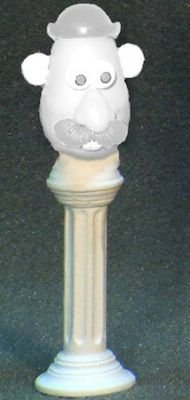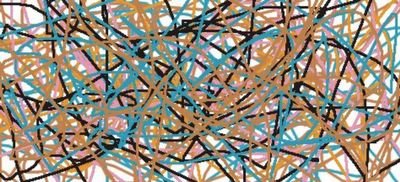A Very Brief History of Art, Featuring Mr. Potato Head
As part of my never-ending quest to make the Llamabutchers one day say, "Holy crap, that Sobek fellow is so geeky, he makes us look flat out hip!" as well as part of certain court-ordered community service (I was framed, BTW), I now present for your education, a Very Brief History of Art, Featuring Mr. Potato Head. I hope you enjoy. [Note: you can enlarge some of the pictures by clicking on them].
The history of art, of course, is as old as the history of man. In the famous Lascaux cave, somewhere in France, some of the earliest drawings known to man depict rudimentary images of primitive life.

Note that our unknown artist focuses on things that would have been part of his or her daily routine: crude animal domestication, including the birth of a foal, as well as horticulture, as reflected by the potato-shaped drawing near the top. Some scholars speculate that the potato-figure's bulbous hat has some reference to ancient pagan fertility rites, but of course the question must forever remain open to speculation.
The Greeks are one of the oldest civilizations, and one of the most advanced in the world at their time. They excelled at mathematics, philosophy, music, warfare, wearing togas all day, and of course, art. Greek statuary had a tremendous influence on the Egyptians, and later the Romans. But it was in the private lives of individuals that some of the most fascinating works appear.

In this urn, we see the potato figure again, but this time in a more stylized form than at Lascaux. Recent discoveries on the island of Crete have created a near-consensus that this urn represents an ancient myth, in which Zeus transformed himself into a tuber of some sort, in order to seduce the Minoan Queen. The fact that three such potatoes appear has led some to speculate a proto-trinitarian religious theme, but such a theory has very little support.
The Greeks were conquered piecemeal by the Romans, whose military prowess took them all over the known world. But the Romans adopted much of Greek culture, and indeed it may fairly be said that while the Romans conquered the Greeks, the Greeks were busy conquering the Romans.
 In this simple sculpture, we see that the Romans adopted the Greek focus on excellence of form, as well as the underlying potato-based mythos. This obsession with copying everything the Greeks did has led some scholars to describe the Romans as "history's wankers."
In this simple sculpture, we see that the Romans adopted the Greek focus on excellence of form, as well as the underlying potato-based mythos. This obsession with copying everything the Greeks did has led some scholars to describe the Romans as "history's wankers."Eventually the Roman empire divided into East and West, with the eastern capital at Constantinople (later named Istanbul, but that's nobody's business but the Turks'. Well, the Turks' and a bunch of dead Greeks who were massacred in the process). While the Western empire fell quickly into decline, being sacked repeatedly by such Germanic tribes as the Goths, the Vandals, the Hooligans, and the Ne-er-do-wells. But the Eastern Empire produced some beautiful artworks, especially Christian-centered mosaics.

This is a mosaic portrait of the Emperor Theodorus, who opted to be depicted as sporting a large, bushy moustache and with a bulbous, orange nose.
My back hurts, so I'll just skip over the pre-Raphaelites and the High Renaissance entirely. With the baroque style came Caravaggio, one of the most important artists who used the chiaroscuro technique.

In this classic scene from the Apochrypha, Judith is seen making julienne fries for Holophernes, if I remember the story correctly. Note the stark contrast between light and shadow, the attention to realism, and that old woman on the right side. I mean, what's she up to? Probably nothing good.
While the Italians in the South and the Dutch and Germans in the north were making art that scholars classify as "good," a bunch of Frenchmen like Fragonard invented Rococo (a Portugese word meaning "roast cocoa"). This style is characterized by frilly lines, bright colors, and, frequently, naked women. That's the French for you, I suppose.
 In this piece, entitled "The Swing," we see that the Rennaissance focus on line and form has been abandoned in favor of frill and fluff. As in, "wow, these sure is some fluffy mashed p'taters, Cletus!" That kind of fluff.
In this piece, entitled "The Swing," we see that the Rennaissance focus on line and form has been abandoned in favor of frill and fluff. As in, "wow, these sure is some fluffy mashed p'taters, Cletus!" That kind of fluff.At this point, artists pretty much decided they were sick of trying to fit into easily classified groups, so they all went totally nuts. For example, Georges Seurat developed the pointilism style, in his famous Sunday avec une pomme de terre:

This painting, however, is better-known for its prominent role in the movie "Ferris Beuller's Day Off."
Then some jokers developed Cubism, probably to poke fun of rapper Ice Cube. I would identify the artist and the name of this piece, but let's be honest: no one can tell cubist paintings apart.

Frankly, if you need me to tell you that Pablo Picasso was whacked out on acid, then you need more art history help then you're going to find on this blog:

Vincent Van Gogh really has no excuse for his garish use of color. I mean, he cut off his hear, not his eye. Then again, I guess a guy who is psycho enough to cut off his ear is probably unstable enough to think the color scheme in this one works well:

Meanwhile, Jackson Pollock was a raging drunk. Exhibit A:

As you can see from the last four pieces, the modern trend has been to abandon rigid requirements of form, with certain artists experimenting with mere elements of art, such as rhythm, color, or mood. An excellent example of this modern trend is Mark Rothko, whose bare-bones works can still manage to evoke emotion -- be it peace, agitation, or narcolepsy (um, does that count as an emotion?), as exemplified by the following work:

Another important modern artist, Andy Warhol, was ... um ... okay, I actually am not quite sure why this guy is famous, to be perfectly honest with you.

There you have it: a very brief history of art from prehistory to the present. Where will the future of art take us? I'll share some of my own thoughts on the subject in a follow-up post. I hope this has been as enlightening for you as it has been for me.




<< Home